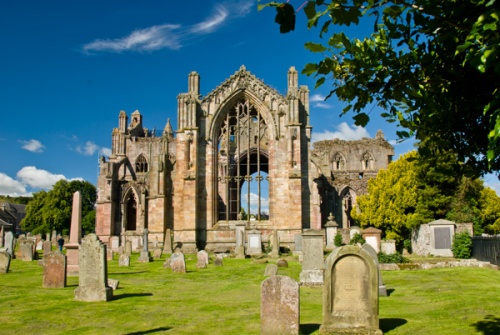
Melrose is a historic town on the south bank of the River Tweed. It is also one of the most beautiful places in the Borders, in a lovely setting beneath the Eildon Hills. Melrose was named the best place to live in Scotland in a 2018 poll by the Sunday Times newspaper.
In the market square is the Three Hills Roman Heritage Centre where you can learn about Trimontium, one of the largest Roman forts in Scotland, which stood at Newstead, just east of Melrose on the south bank of the river.
Eildon Hills
Trimontium means 'place of the three hills', a reference to the Eildon Hills that tower over Melrose and dominate the landscape for miles around. Atop the hills are the earthen ramparts of a large Iron Age fort. Local tradition says that Eildon is a 'hollow hill'.
Sir Walter Scott embellished the tradition and wrote a popular story where a horse trader is taken inside the hill at night and discovers King Arthur and his knights asleep within.
We are firmer ground when it comes to the hill fort; we know that it was settled as early as 1000 BC and covers 16 hectares, which would have supported as many as 6,000 residents. The Romans built a fort below the summit in AD 80 and erected a signal tower inside the hill fort enclosure.
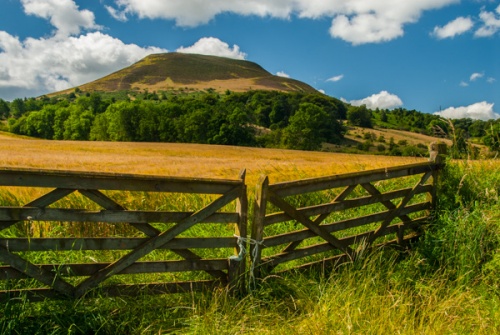
The Rhymer Stone
At the base of the hill is the Rhymer Stone, marking the site of the Eildon Tree, the traditional meeting place of Thomas the Rhymer and the Queen of the Faeries.
Rhymer was a 13th-century laird with a gift for prophecy whose adventures, real and fancied, were woven into popular folklore until it is hard to know where fact ends and fiction begins. Rhymer was a native of Earlston and used to rest under a hawthorn tree here.
One day he met the faerie queen, who took him into the faerie realm where he dwelt for seven years. Some versions say he returned to the world of humans with the ability to only speak the truth, or, alternately, the gift of being able to foretell the future.
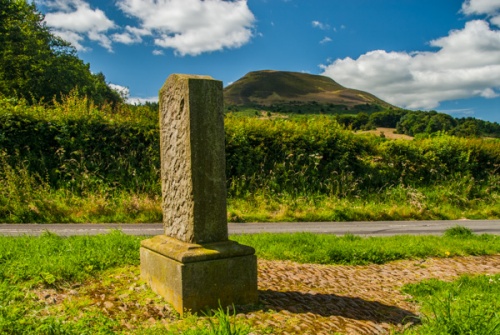
Melrose Abbey
While large parts of the Thomas Rhymer story are romantic fancy, the equally fascinating story of Melrose Abbey and its place in Scottish history is true. The Abbey was founded in 1136 by King David I and was the first Cistercian monastery in Scotland.
The abbey owned vast tracts of land in the area where they raised sheep, and it was the wealth from the sheep's wool that made Melrose Abbey one of the richest monasteries in medieval Scotland.
The most famous abbot was Waltheof, the stepson of David I, who was venerated as a saint after his death even though he was never canonised.
Melrose Abbey became so important on the national stage that King Robert Bruce's dying wish was to have his heart carried on crusade, then buried by the high altar in Melrose Abbey. Bruce's wishes were carried out; his body was buried at Dunfermline Abbey but his heart was interred at Melrose. King Alexander I was also buried at Melrose Abbey.
The abbey was damaged several times by English attacks during the Scottish Wars of Independence and again by Henry VIII during his 'Rough Wooing' in the 1540s.
Most of the abbey remains date from the 14th-16th centuries. The abbey church is famous for its superb carvings, including one carving of a pig playing the bagpipes and another of a cook with a soup ladle.
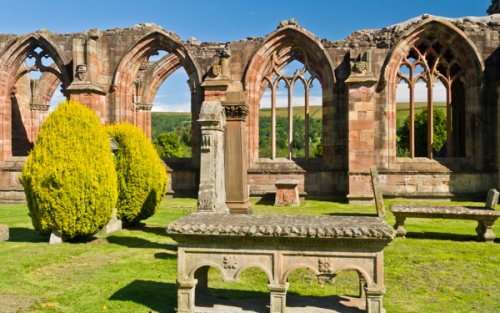
Harmony Garden
Directly opposite the ruins of Melrose Abbey is Harmony Garden, a beautiful walled garden surrounding an elegant Georgian mansion. The mansion is let as holiday accommodation and thus not open to the public but the three-acre gardens are. Here you can enjoy colourful flower beds, wide lawns and an orchard area as well as a kitchen garden.
Harmony House was built by a wealthy plantation owner named Robert Waugh, a friend of Sir Walter Scott. The last private owner of the house gave it to the National Trust for Scotland so that the house and garden would be available for everyone to enjoy. The setting is amazing, with views across to the soaring arches of Melrose Abbey over the wall.
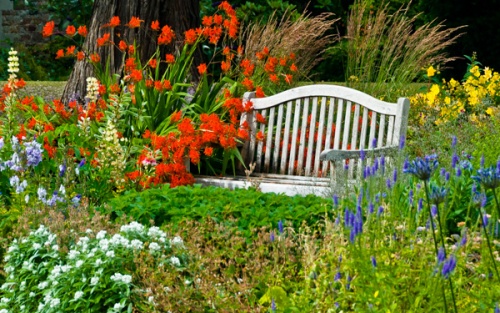
Priorwood Garden
Melrose is fortunate to have not one but two historic walled gardens within a short stroll of each other. Priorwood Garden stands within the former precinct of the medieval abbey and includes an orchard where several historical varieties of apples are preserved.
The orchard probably began as part of the monk's kitchen garden. The gardens cover 2 acres and have a special focus on plants suitable for drying. There is also a small woodland garden area, adding an informal touch.
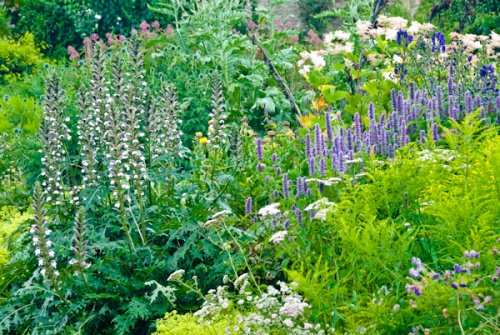
Abbotsford
Just outside Melrose is Abbotsford House, home of the author Sir Walter Scott. Scott called his home 'romance in stone and mortar', and that's a fair description. Abbotsford was inspired by Scotland's heritage and contained pieces from a variety of dwellings across the country.
It was the house that launched the architectural style known as Scottish Baronial, a fashion that was copied throughout Scotland for the next 80 years, becoming an unofficial national style.
Queen Victoria stayed at Abbotsford on her first visit to Scotland and was so influenced by it that she remodelled the royal residence of Balmoral Castle in the same style.
The house boasts a wealth of memorabilia associated with Scott, and items he collected on his travels. You can see the wood-panelled study where he wrote some of his most famous works. The house is set in superb gardens including a walled garden and a pleasant woodland with walking trails.
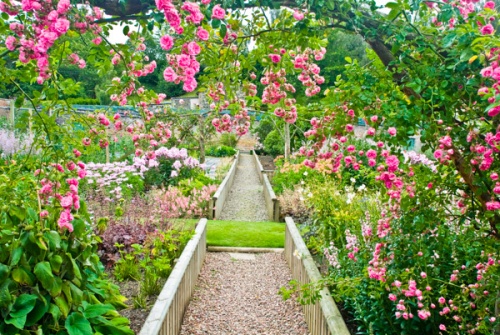
Lauderfoot Railway Viaduct
Just east of Melrose and just beyond the site of Trimontium is the iconic Leaderfoot Viaduct, built in 1865 to carry the Berwickshire Railway across the River Tweed. Nineteen high, slender arches support the viaduct, which closed to passenger traffic following severe floods in 1948.
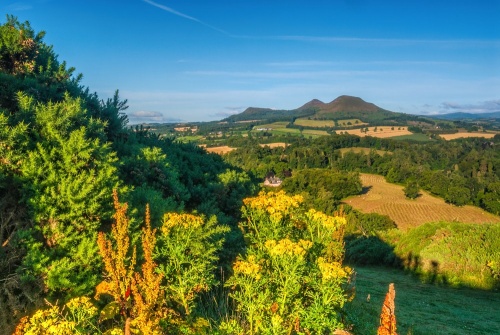
Scott's View
On the hillside above the Leaderfoolt Viaduct is Scott's View, a panoramic viewpoint favoured by Sir Walter Scott. The viewpoint gives outstanding views over the Tweed valley and across to the Eildon Hills. According to tradition, Scott's horses stopped at the viewpoint so often during his lifetime that when they were pulling his funeral cortege to Dryburgh Abbey in 1832 they stopped at the viewpoint our of habit.
The Melrose Sevens
Melrose is famous amongst sports fans as the birthplace of rugby sevens, an adapted form of the 15-a-side game that emphasises fitness. The idea of a seven-a-side match with two seven-minute halves was first proposed by a Melrose native in 1883. The town hosts the annual Melrose Sevens tournament of rugby sevens that draws teams from across the world.
About Melrose, Scottish Borders
Address: Melrose,
Borders,
Scotland
Attraction Type: Town
Location: On the A6091, six miles east of Galashiels
Location map
OS: NT546341
Photo Credit: David Ross and Britain Express
POPULAR POSTS
HERITAGE
 We've 'tagged' this attraction information to help you find related historic attractions and learn more about major time periods mentioned.
We've 'tagged' this attraction information to help you find related historic attractions and learn more about major time periods mentioned.
Find other attractions tagged with:
NEARBY HISTORIC ATTRACTIONS
Heritage Rated from 1- 5 (low to exceptional) on historic interest
Priorwood Garden - 0.1 miles (Garden) ![]()
Melrose Abbey - 0.1 miles (Abbey) ![]()
Harmony Garden - 0.2 miles (Garden) ![]()
Eildon Hills - 1.2 miles (Countryside) ![]()
Leaderfoot Railway Viaduct - 1.8 miles (Historic Building) ![]()
Abbotsford House - 2.3 miles (Historic House) ![]()
Scott's View - 2.9 miles (Countryside) ![]()
William Wallace Statue - 3 miles (Historic Building) ![]()
Nearest Holiday Cottages to Melrose, Scottish Borders:
More self catering near Melrose, Scottish Borders



